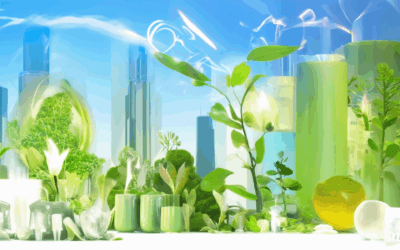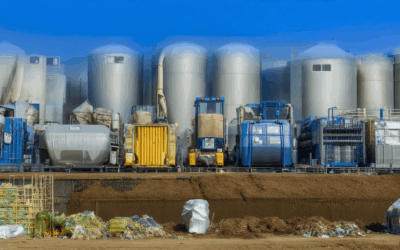In today’s rapidly evolving world, the quest for sustainable solutions has never been more urgent. Among the most promising advancements in waste management is the integration of innovative recycling methods with pyrolysis technology, revolutionizing how we approach resource recovery and environmental stewardship. This article delves into the transformative potential of pyrolysis in modern recycling, exploring its role in enhancing traditional processes and paving the way for a greener future. By examining cutting-edge applications, case studies, and future trends, we’ll uncover how pyrolysis is not just a technological innovation but a cornerstone of sustainable waste management. From improving material recovery rates to reducing environmental impact, pyrolysis is poised to redefine recycling practices globally. Join us as we dissect the innovations driving this movement and their implications for achieving long-term sustainability goals.

How Does Innovative Recycling Work With Pyrolysis?
Pyrolysis is a cutting-edge recycling technology that transforms waste into valuable resources through a controlled heating process at high temperatures in the absence of oxygen. This process breaks down complex organic and synthetic materials into simpler substances that can be reused in various industrial applications.
The Process of Pyrolysis
- High-temperature treatment of waste materials (typically between 500-800°C)
- Breakdown of materials into carbon-rich char, aromatic compounds, and syngas
- Production of energy in the form of heat, steam, and electricity
Benefits of Pyrolysis in Recycling
- Reduction of Landfill Dependency: Diverts waste from landfills, minimizing methane emissions and conserving space
- Resource Recovery: Extracts valuable materials like biochar and syngas for reuse in manufacturing and energy production
- Sustainable Energy Generation: Generates renewable energy while managing waste, supporting circular economy principles
Competitors and Market Position
Pyrolysium competes with established players like Covanta and Waste Management, which have also adopted pyrolysis technologies. However, our approach emphasizes scalability and cost-effectiveness, making us a competitive choice in the waste-to-energy sector.
Applications and Comparisons
While pyrolysis is similar to composting in its ability to process organic waste, it has a broader application range, particularly for materials like plastics that aren’t typically compostable. This versatility makes pyrolysis a vital component in modern waste management strategies.
The Future of Waste Management
Innovative recycling methods like pyrolysis are essential for achieving zero-waste goals. By integrating pyrolysis with other waste management practices, we can create a more sustainable future that minimizes environmental impact and maximizes resource utilization.
Explore how Pyrolysium is leading the charge in sustainable waste solutions by visiting our website and discovering our cutting-edge recycling technologies.
What Innovations are Involved in Recycling Materials Through Pyrolysis?
Pyrolysis has seen significant advancements in recent years, particularly in how it processes and recycles materials. Here are some key innovations:
- Advanced Temperature Control : Modern pyrolysis systems utilize precise temperature regulation, allowing for optimal decomposition of various materials. This ensures consistent product quality and minimizes energy waste.
- Real-Time Monitoring and Automation : Innovations in sensor technology enable continuous monitoring of temperature, pressure, and airflow. Automated systems adjust parameters in real-time, enhancing efficiency and reducing variability.
- Catalytic Enhancements : The use of catalysts has improved the rate and efficiency of pyrolysis. These catalysts can accelerate the breakdown of complex organic materials, making the process more effective.
- Waste Fractionation : New techniques allow for the separation of waste into specific fractions before pyrolysis. This ensures that the process targets the most suitable materials, optimizing resource recovery.
- Energy Recovery Systems : Cutting-edge pyrolysis systems now incorporate advanced heat recovery and energy generation components. This captures and utilizes the energy produced during the decomposition process, increasing overall sustainability.
- Scalable and Portable Units : Innovations in modular design have led to the development of portable pyrolysis units, ideal for remote locations or small-scale operations. Larger, industrial-scale facilities are also more efficient and capable of processing higher volumes.
- Sustainable Design : Recent designs prioritize energy efficiency and reduced emissions. Improved reactor configurations minimize environmental impact while maximizing resource recovery.
- Research and Development : Ongoing R&D efforts focus on optimizing pyrolysis for a wider range of materials, including plastics and textiles. This expansion enhances the versatility of pyrolysis as a recycling method.
These innovations collectively enhance the effectiveness and sustainability of pyrolysis, making it a leading solution in material recovery and recycling.

How Do Innovative Recycling Methods Utilizing Pyrolysis Improve Sustainability?
Innovative recycling methods that employ pyrolysis are revolutionizing how we manage waste and contribute to sustainability. Pyrolysis, a thermal decomposition process, transforms organic waste into valuable resources like biochar, biogas, and carbon dioxide. This process not only reduces landfill dependency but also enhances soil fertility and energy production.
The Benefits of Pyrolysis-Based Recycling
- Reduction of Landfill Waste: By converting organic waste into usable materials, pyrolysis significantly decreases the amount sent to landfills, thereby preserving natural resources and reducing environmental degradation.
- Energy Recovery: Pyrolysis produces biogas, which can be used for electricity generation or heating, making it a renewable energy source. This reduces reliance on fossil fuels and contributes to a circular economy.
- Soil Improvement: Biochar, produced through pyrolysis, acts as a natural fertilizer, improving soil health and crop yields. It also sequesters carbon, aiding in carbon capture and greenhouse gas reduction efforts.
- Waste Management Efficiency: Unlike traditional recycling methods, pyrolysis can handle a wider range of waste materials, including those that are typically difficult to recycle, such as plastics and food scraps.
Comparison with Traditional Recycling Methods
Pyrolysis-based recycling often surpasses traditional methods in efficiency and environmental impact. While traditional recycling focuses on sorting and reprocessing materials, pyrolysis breaks down waste into its constituent elements, extracting maximum value from every piece. This holistic approach ensures fewer wasted resources and a more sustainable cycle of material use.
Competitors and Market Position
Several companies and organizations are actively involved in advancing pyrolysis technology, including Pyrolysium . These players emphasize the importance of developing scalable and cost-effective pyrolysis systems to meet global sustainability goals. While competitors may offer similar solutions, Pyrolysium stands out for its commitment to education, innovation, and community engagement in sustainable practices.
Future Outlook and Adoption
The adoption of pyrolysis-based recycling is gaining momentum as governments and corporations recognize its potential to drive sustainability. Initiatives like UK’s Circular Economy Plan highlight the importance of innovative recycling methods to achieve zero-waste targets. As technology advances and public awareness grows, pyrolysis is expected to play a pivotal role in shaping a more sustainable future.
By embracing innovative recycling methods like pyrolysis, we can collectively reduce our environmental footprint and move closer to a world where resources are used efficiently and waste is minimized. Pyrolysium is committed to leading this charge, providing the knowledge and tools needed to make sustainable choices accessible to everyone.

Enhancing Innovative Recycling with Pyrolysis
Pyrolysis offers a groundbreaking approach to recycling by transforming organic waste into valuable resources. This thermal decomposition process occurs at high temperatures without oxygen, breaking down materials into biochar, char, and other useful byproducts. Unlike traditional recycling methods, pyrolysis can effectively process materials that are typically challenging to manage, such as food scraps, yard waste, and certain plastics.
One of the key advantages of pyrolysis is its ability to recover energy from waste. The process generates heat, gas, and syngas, which can be utilized for electricity production or industrial processes, significantly reducing the environmental footprint of waste management.
To further enhance recycling efforts, pyrolysis complements existing systems by handling organic waste that would otherwise go to landfills. This not only reduces landfill volume but also minimizes methane emissions, a potent greenhouse gas produced during decomposition.
At Pyrolysium, we are committed to advancing sustainable solutions through innovative recycling technologies like pyrolysis. Our platform educates individuals and communities on eco-friendly practices, encouraging widespread adoption of greener technologies to combat climate change and promote a circular economy.
How Pyrolysis Works
Pyrolysis involves heating organic materials between 300°C and 700°C in a controlled environment. The process yields biochar, a stable carbon-rich material known for its ability to sequester carbon and improve soil fertility. Additionally, it produces syngas, a versatile energy source that can be converted into electricity or fuels.
Energy Recovery and Sustainability
By integrating pyrolysis into recycling streams, cities and industries can harness energy from waste, contributing to renewable energy sources and reducing reliance on fossil fuels. This dual benefit of waste conversion and energy generation makes pyrolysis a vital component of sustainable waste management strategies.
Complementary Recycling Systems
Pyrolysis serves as a complementary technology to traditional recycling methods. While it excels at managing organic waste, conventional recycling techniques continue to play a crucial role in processing materials like glass, metals, and plastics. Together, these approaches create a more holistic waste management framework.
Competitor Insights
Several companies are actively involved in advancing pyrolysis technology, including Carbon Revolution and others. These competitors bring unique innovations and approaches to the field, highlighting the importance of collaboration and competition to drive progress. Visit Carbon Revolution to explore their contributions to sustainable waste solutions.
A Path Forward
Pyrolysium advocates for a future where innovative recycling technologies like pyrolysis are integral to global waste management. By fostering education, collaboration, and technological advancement, we can create a more sustainable and resource-efficient world.
Through pyrolysis, we not only transform waste into valuable resources but also pave the way for a cleaner, greener planet. Explore our resources and learn how you can contribute to this movement at Pyrolysium .
Combining Recycling with Pyrolysis Technology
Innovative approaches that merge recycling with pyrolysis technology aim to enhance waste management and promote sustainability. By integrating pyrolysis, a thermal process that converts organic waste into biochar and other valuable materials, these methods contribute to a circular economy.
- Municipal Waste Management: Many cities are adopting programs where organic waste is collected and pyrolyzed to produce biochar, reducing landfill dependency and creating a reusable resource for agriculture.
- Industrial Recycling Streams: Companies are utilizing pyrolysis to transform industrial scraps and plastic waste into fuels or raw materials, thus minimizing environmental impact and promoting resource efficiency.
- Agricultural Applications: Biochar produced through pyrolysis is being used as a soil amendment to improve agricultural productivity, supporting sustainable farming practices.
- Decentralized Systems: Community-level pyrolysis units are being developed to empower local populations to manage waste effectively, fostering environmental stewardship and self-sufficiency.
These approaches are exemplified by initiatives in cities like Singapore, where pyrolysis pilots are underway, and companies such as Veolia and Waste Management Inc., which are leading innovative recycling solutions.

Benefits of Innovative Recycling Combined with Pyrolysis Technology
Innovative recycling paired with pyrolysis technology offers a holistic approach to waste management, providing numerous environmental, economic, and operational advantages. Here are the key benefits:
- Enhanced Waste Reduction: By integrating advanced recycling methods with pyrolysis, the process effectively converts a broader range of materials into valuable resources, significantly reducing landfill dependency.
- Cost Efficiency: Pyrolysis technology often processes materials that are difficult or costly to recycle traditionally, lowering overall expenses associated with waste disposal and resource recovery.
- Energy Recovery: Pyrolysis generates energy in the form of biochar and syngas, providing a sustainable energy source and potentially offsetting operational costs.
- Greenhouse Gas Mitigation: Reducing the volume of waste sent to landfills and converting organic materials into biochar helps lower greenhouse gas emissions, contributing to climate goals.
- Sustainable Material Utilization: Both innovative recycling and pyrolysis ensure that materials are repurposed or converted into resources, minimizing the environmental footprint of waste management operations.
These technologies work synergistically, enabling a circular economy where waste is transformed into valuable assets rather than a burden. Companies like Pyrolysium have successfully implemented such integrated systems, achieving notable reductions in waste and costs while promoting sustainability.
For more details on how Pyrolysium leverages these technologies, explore our resources on sustainable solutions and recycling technologies .




0 Comments